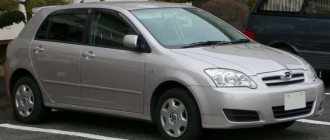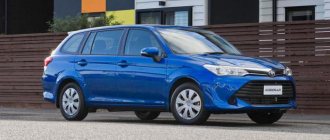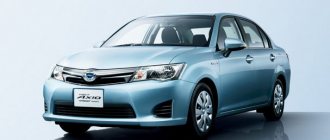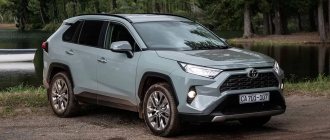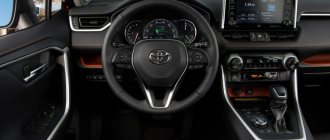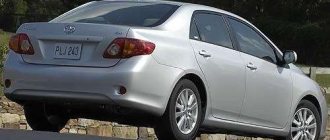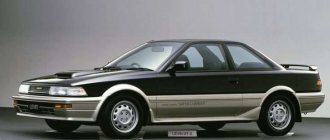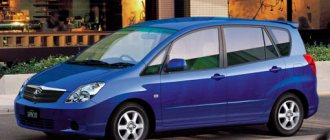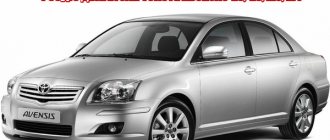The release of the Toyota Corolla e170 undoubtedly pleased and met the hopes of car enthusiasts. The car has become more technically advanced, its safety has been improved, its exterior design has been modernized, and the interior has become more spacious and comfortable. The Corolla retained its position as the best-selling car. To feel the perfection of the new car, let’s take a closer look at these changes.
Toyota Corolla E170 is the 11th generation Corolla, presented for the American market in 2013. In Europe, the eleventh generation of Corolla is represented by the Toyota Corolla E160, which was presented a few days later.
Exterior and interior design of Corolla 170
Which Corolla do you like best?
Upper American or lower European? The development of the exterior design of the car, as well as the interior of the eleventh generation Corolla e160 and e170, was a logical continuation of Toyota traditions and trends. But the eleventh generation model has introduced modern elements that make the Corolla 170 attractive and also noticeable among other cars.
Exterior Features
The addition of rounded body contour lines to the Corolla model made the design sporty and stylish. The sporty look of the car is also emphasized by the sharp angle of the C-pillar, recessed door handles, rounded front optics with LEDs, as well as the shape of the rear lights. Additional attractiveness is created by the radiator grilles converging in the center with the brand name. The design of the Corolla 170 is slightly different from the European version of the E180 in the shape of the rear and front bumpers and optics.
Interior features
How do you like the interior of the Corolla 170?
The interior of the Corolla E170 is characterized by three words: style, functionality, aesthetics. On the structured instrument panel, the scales are easily visible and accessible to the driver. A multi-wheel steering wheel with instrument controls emphasizes functionality, and decorative inserts on the front of the dashboard and a decorative cover on the gear lever add unique style.
Center panel Corolla 180
The interior design varies depending on the predominant color and materials. The seats have retained a convenient location for passengers. The variety of interior of the Toyota Corolla 170 is determined by the number of trim levels. The more expensive the equipment, the better the materials and the more expensive the Corolla.
Exterior
The new body of the Toyota Corolla e170 received a sporty appearance, in which the main feature was an updated bumper, with a trapezoidal air intake grille, and head optics. These changes gave the car a modern look, and the front end became more aggressive . To highlight the new design and visually reduce bulk, streamlined and more compact LED headlights were used.
Due to the fact that their heating temperature is low, lightweight lenses were installed that replaced ordinary glass. This is one of the first sedans to feature LED headlights. Thus, we can say that the car has an Asian profile . The door handles have a custom design that is set deep into the door, this is done so that the line is uniform. The rear of the Toyota Corolla has not changed that much; the rear pillars are made at a sharp angle, which makes the car look more sporty. The back has become massive, but at the same time a little narrow.
Specifications
During the development of the eleventh generation Corolla e170, the latest achievements of engineering were implemented, which made it possible to qualitatively improve the technical characteristics of the car. Many components and systems of the Toyota Corolla 170 have undergone design changes.
Engine and transmission Corolla 160
Corolla 170 under the hood
The Toyota Corolla E170 is equipped with two brands of engines. Both are petrol 1.8 2ZR-FE with 132 hp with a dual VVT-i system, the second engine is also 1.8 2ZR-FAE producing 140 horsepower. The 1.8 2ZR-FAE engine is considered an analogue of the 1.8 2ZR-FE. They have similar technical characteristics in terms of volume, compression ratio, torque, fuel consumption, and other parameters.
The Corolla E170 is equipped with three types of transmissions: manual with 6 speeds (6 manual transmission), automatic (automatic transmission) with 4 speeds on cheap models, as well as a continuously variable transmission, which is the main one for the Corolla E170.
Each gearbox is characterized by driving characteristics and also differs in fuel consumption. A comparison of gasoline consumption data for Corolla E170 cars, which differ in configuration only by gearbox types, shows that the most economical gearbox is a CVT, then a 6-speed manual transmission, and in last place is an automatic transmission. So, consumption with a 6-speed manual transmission is 8.4 liters per 100 km when driving in the city, 6.4 liters per 100 km outside the city and 7.6 liters per 100 km in mixed traffic. Gasoline consumption with automatic transmission under the same conditions is 8.7, 6.5, 7.6 liters per 100 km, respectively, and fuel consumption with a CVT is 8.1, 6.2, 7.3 liters per 100 km, respectively.
Dimensions and volumes
Interior size of Corolla 170
Two consumer qualities of a car are associated with dimensions: city handling and interior comfort. Smaller dimensions - easier to park. But with smaller dimensions, the interior is smaller, and a cramped cabin has less comfort. Having once again increased the size of the Toyota Corolla E170 model, the Japanese gave preference to comfort. The dimensions of the eleventh generation Corolla E170 are 4620 (length) x 1775 (width) x 1465 (height) mm with a wheelbase of 2700 mm. The increase in interior dimensions was not simply due to an increase of 80 mm in overall length, but mainly due to an increase of 100 mm in the wheelbase, as well as an increase of 15 mm in the width of the car. Reducing the height by 5 mm improved aerodynamic properties. The trunk volume and fuel tank capacity remain the same – 450 and 55 liters.
Security systems
Beautiful white interior of the Corolla
In terms of safety, the Toyota Corolla 170 meets the highest global requirements. In Euro NCAP crash tests, the Corolla E170 received the highest score - 5 points. The safety of the Corolla E170 is supported by active and passive safety systems.
Passive safety in the Corolla is ensured by design solutions that reduce the risk of injury to passengers and pedestrians. The steel body of the Toyota Corolla has fairly high shockproof properties. And to protect against side impacts, reinforced side members and side cross members are built into the body.
Feed Corolla 170
There are 7 airbags installed in the cabin.
The design of the front seats reduces the likelihood of neck and spine injuries; all seats are equipped with three-point seat belts.
Active safety is ensured by the driver's influence on systems that change the vehicle's motion parameters. In the basic configuration, the active safety of the Corolla E170 includes an anti-lock braking system, an emergency brake booster, and an electronic brake force distribution system. Higher trim levels already come with Vehicle Stability Control (VSC) with Traction Control (TRC) and Hill Start Assist Control (HAC). Particularly noteworthy are electronic safety systems that signal possible collisions, lane departures, remind you of road signs, and also automatically control the high beams.
Swift red Corolla
Toyota Corolla XI generation E 160 / E 170
The times when the Corolla was considered the standard are, alas, passing. According to the international car reliability rating (TUV), over the past 10 years, Corolla has retreated from the TOP 10 to the end of the “twenty”, or even the beginning of the third ten. Globalization, unification and other modern “diseases” of the automobile industry force manufacturers to save money. Yes, and competitors have got their hands on it. How the same Koreans have grown!
Story
TOYOTA COROLLA was first shown in 1966. It was a small rear-wheel drive 2-door sedan with 60 horsepower. By the sixth generation in 1987, the model was already known as an authority in the field of reliability. However, over the entire period of its production, the engine was more powerful than 192 hp. the model didn't have one. In addition, Corolla has always changed evolutionarily and carefully.
Toyota Corolla seventh generation (E100) 1991-1997. Ninth generation Toyota Corolla (E 120) since 2001. Tenth generation Toyota Corolla X generation E 140/E 150 from 2006 to 2013. Eleventh generation Toyota Corolla XI generation E 160 / E 170 since 2012
In a word, complaints about the 11th generation of the car (E170) on the Internet are no less common than about the previous model E150, which was pulled down by the “robot” hated by many, which has now, fortunately, sunk into oblivion. Indeed, since 2012, under the hood of the model, in addition to the generally reliable “mechanics”, the Multidrive S variator has settled. Zakidonov, like its predecessor - the so-called multimodal (multi-mode) MMT gearbox (in the “robot”) - is not found here. Except for the peculiarity of hanging tightly after slipping for a few seconds. But this is not a breakdown.
Russian Corollas were offered three gasoline engines: 1NR-FE (1329 cm3, 99 hp); 1ZR-FE (1598 cm3, 122 hp) and 2ZR-FE (1798 cm3, 140 hp). Actually, there are no complaints about them. As they say, Japanese remains Japanese. Unless there are complaints about irregular cold starts. But this was rather a problem with cars with manual transmission. The clutch is not fully depressed during start-up, and its adjustment is not provided here.
The body is welded from galvanized but thin steel, and here again the environment intervened. The primer and paint are now water-based, which significantly distinguishes the current corrosion resistance from the previous one - reinforced concrete. In our case, the “redhead” makes its way out in an even layer through microcracks. Today it does not cause much trouble, since it resembles a kind of “soot” deposit from the road and can be easily removed in a car wash. So wash your car more often, otherwise scratches and chips quickly appear on the body. Especially along the bottom edge of the doors. We recommend immediately “treating” deep “wounds” with special means, and in winter treating the body with protective polishes or liquid wax.
There were also negative changes in the interior. Aesthetically, he may have improved, but he clearly lost in quality. Owners complain about gaps in the upholstery, causing “crickets” to appear. The instrument panel visor is noisy, as is the panel itself. You can hear some kind of life in the lampshade (by the way, condensation can accumulate there, which then drains under the casing). The lowered window panes also refuse to remain silent.
It is difficult to make serious claims regarding the chassis, although, keeping in mind the past merits of the Corolla suspension, which survived even in our regions for many years, its safety margin has noticeably decreased. For the first time, attention was attracted to the front suspension already at 40 thousand km: struts and stabilizer bushings. Although the Japanese installed reinforced suspension in Russian cars. It’s already good to interfere with the rear chassis after 100 thousand km, when the shock absorbers had to be changed (5,000 rubles each). Silent blocks can last twice as long. The situation with on-board electrics is also good. But this is only in the southern regions. She can hardly stand the cold. It happens that the battery dies, the electric mirrors and door locks malfunction...
In short, the Corolla remains a desirable and durable car, but now only in comparison with its current competitors. And it has not yet lost its main trump card - liquidity. And “thank you” to progress, “thanks to” which now all used cars have to be taken to a service center for diagnostics before purchase.
TRANSMISSION
The transmission does not bother you during delicate use. In cars with manual transmission, it is not uncommon for the clutch pedal to squeak. The unit requires lubrication. The clutch takes care of 90-150 thousand kilometers. Depending on the management style. The cost of replacement is about 20,000 rubles. It is surprisingly difficult to find negative information about the Multidrive S variator on the Internet. The instruction manual lists it as maintenance-free. But we know that this does not happen.
ENGINE
Motorists see the 1.6 engine as the most resourceful, which runs 350 thousand km or more without repair. All engines have a timing chain drive, designed for a mileage of 250 thousand km, with diagnostics for 150 thousand kn. Replacing the timing drive will cost about 20,000 rubles including spare parts. Minor troubles include oil leaks from under the valve cover gasket after 100 thousand km, as well as from the front crankshaft oil seal or from under the pan gasket.
SUSPENSION
The first ones at 40 thousand kilometers in the chassis will be asked to replace the strut and bushing of the front stabilizer (for a circle of about 6,000 rubles). After 70 thousand km, the worn support bearings of the struts will creak (2,500 each). Shock absorbers (around 6,500 rubles) run for over a hundred. And the ball joints (2,000 each) have twice the service life - they are strong. The rear suspension will remind itself only after 100 thousand km.
BODY
Sometimes the doors and trunk close with force. Water easily penetrates inside the doors (window seals are not provided) and freezes there, completely or partially blocking the locking mechanisms or window lifts. In cold weather, the cable for remotely opening the trunk lid also freezes. The situation is not pleasant: you can open it, but you can’t close it. In addition, it happens that the trunk lid opens while driving.
ELECTRICAL
Some note the short service life of air flow (1,200 rubles) and coolant temperature (500 rubles) sensors, which last an average of only 60 thousand km. But the vagaries of the side rear-view mirrors, when in the cold after washing they forget the correct position and fold forward, have already been noted by many. Not everyone succeeds in returning them to their place.
ADVANTAGES AND DISADVANTAGES
+ Reputation, residual value, 1.6 engine, transmission, suspension
— Paintwork, quality of fit of interior trim materials, wear resistance of the driver’s seat, low resistance to frost
Options
Toyota Corolla 170 is manufactured in four trim levels: L, LE, LE Eco and S. The interior decoration, devices that provide comfort and safety depend on the trim level. After restyling in 2021, the basic equipment of the Corolla 170 includes:
- Toyota Safety Sense electronic safety system;
- anti-lock braking system ABS;
- high-quality air conditioning;
- heated front seats;
- front airbags;
- electric windows;
- diode running signals;
- heated mirrors, electrically controlled.
At the top, the Corolla 170 offers:
- LEDs;
- downhill stabilization device with built-in assistance function;
- two-way climate control;
- heated front window;
- rear view camera;
Advantages and disadvantages of the American Corolla 160
The rear sofa folds down.
The advantages of the Toyota Corolla 170 can be summed up in three simple and important words: reliability, safety and comfort. Of course, there are shortcomings, but they are eliminated in subsequent models. Thus, in the Corolla E170, some time after the start of operation, a gap appeared between the gear and the crosspiece of the steering shaft, and with it an unpleasant knocking sound when driving. There were also complaints about the chassis: premature wear of the bushings, fragility of the anti-roll bars and support bearings. During the 2016 restyling, the designers eliminated this defect.
White Corolla
All owner reviews about Toyota Corolla E160
My first car, previously I drove a Lada very sporadically and a little. We can say that there is nothing to compare with. But I’ll write a review anyway, maybe it will help someone in some way.
What I wanted from the car was nothing special, class C, so that it would drive without problems, more or less comfortably, and safely. Considered Ford Focus, Peugeot 407, Renault Fluence. Ultimately, I chose between the Skoda Octavia and Toyota, with Skoda being the leader. The reviews were very good about it, handling, quality, I wanted it with a 1.8 TSI engine - so that there were quite a few horses, and the trunk was a fairy tale, and what it looked like with the rear seats folded down! In general, I would have taken it, but a generational change was brewing, both for Skoda and Toyota. While this was happening, I read about possible problems with turbocharged engines - oil burns, as well as direct fuel injection with our quality of gasoline. This limited the choice quite a bit. The Skoda Octavia came first, looked at it and liked it, both outside and inside. But in terms of content, the engine seems to be a 1.4 TSI (for the money we had), that is, even more loaded than the 1.8, distributed injection and, importantly, in our city the company that sold Skoda lost its license for warranty service. Then came the Toyota Corolla - the appearance, for me, may be a little worse than the Skoda Octavia, but the inside of the Corolla is subjectively better, especially in the version with a multimedia screen (it looks much better than without it in the lower trim levels). The Corolla has more space in the back, the suspension is softer, and the engine is proven, with multipoint injection. Well, the wife made her contribution by sitting on the back sofa, deciding that in terms of convenience there was nothing better than what she had seen. As a result, I made a small deposit on the Corolla. True, I almost changed my mind, because one acquaintance said that after experience on sedans, he would no longer take anything other than a crossover. In general, I looked through the options for the same amount and came across the Nissan Qashqai. And I also liked the car, especially the forward visibility, ground clearance, the presence of ESP, and traction control. But Qashqai was also in a generational change, and neither the type nor the technical characteristics had yet been released, not to mention the start of deliveries. Well, time was running out, prices were rising, they said they would continue to rise, and in the end - Toyota Corolla.
Exterior and inside. It looks quite good, the nose seems a bit heavy, the stern is a bit short, the previous generation seems more harmonious. Overall quite satisfied. Inside, the multimedia screen improves the view, it is convenient to switch the radio, Bluetooth, information is again visible better and - which is very good - there is a rear view camera when reversing. Plays music from a smartphone via Bluetooth (connected without problems, and the equalizer on the phone was also activated, which usually turns on only when the headphones are turned on. Talking is also good, there is a button on the steering wheel, if the phone is connected everything is without problems, both I and the caller can hear well. Toyota asks to transfer the phone book, until I allow it, there is no particular need, I’m not in the car all the time. You can connect a flash drive via USB, a player via AUX, there is also a volume control on the steering wheel and change channels. The sound quality for me is quite good, but a lot I don’t listen - I’m not much of a fan anymore, in the city I concentrate more on driving, outside the city the tires make a lot of noise, I have to turn up the volume, but I don’t like it.
Conclusion
Instruments Corolla 170
In conclusion of this brief review, we note that the eleventh generation Toyota Corolla E170 was the result of the embodiment of the latest advances in technology and design ideas, modern trends in automotive design, while maintaining the reputation of a reliable, comfortable and safe car. Thanks to this, the Toyota Corolla E170 once again confirmed its championship title in the sales market.
